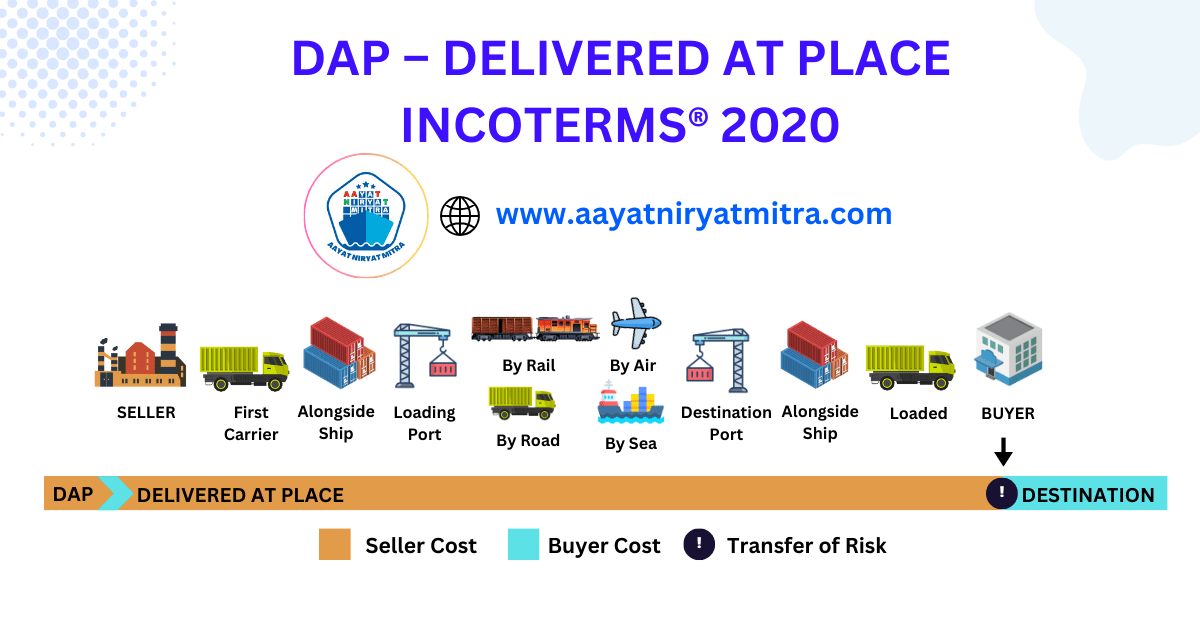Explore the world of DAP Incoterms® 2020. Learn how these trade terms simplify international transactions and ensure seamless delivery at the specified location.
Introduction:
Choosing the correct trade conditions is critical in the world of international trade to ensure a smooth and successful transaction. DAP – Delivery at Place is one of the internationally recognized Incoterms® 2020. In this comprehensive study, we will go into the specifics of DAP Incoterms, how they work, and why they are so important in global trade.
Understanding DAP Incoterms® 2020
What Are DAP Incoterms?
DAP is an abbreviation for “Delivery at Place,” and it refers to a set of international trade regulations outlined in Incoterms® 2020. These agreements expressly state the obligations of both buyers and sellers in terms of costs, risks, and the delivery of products to an agreed-upon location. The seller is responsible for delivering the items to the designated location, ready for unloading, under DAP.
How Does DAP Benefit Buyers?
- Convenience: DAP streamlines the purchasing process by requiring the seller to organize and pay for delivery to the agreed-upon location. This allows purchasers to concentrate on other elements of their business.
- Risk Transfer: DAP transfers risk from the seller to the buyer at the designated destination. Buyers can manage risk and control insurance coverage as they see suitable.
- Predictable Costs: DAP gives purchasers a clear idea of cost allocation, making foreign purchases easier to budget for.
How Does DAP Benefit Sellers?
- Competitive Advantage: Sellers who use DAP can provide a complete solution by ensuring delivery at the stated location, potentially earning a competitive advantage.
- Risk Reduction: Sellers can lower their risk exposure because their responsibility stops once the products are ready for unloading at the designated location.
- Broad Applicability: DAP is adaptable and suited for numerous forms of transportation, allowing marketers access to a global market.
Is DAP Suitable for Small Businesses?
Yes, DAP Incoterms are appropriate for companies of all sizes, including small firms. The unambiguous division of costs and risk in DAP terms advantages both small and large enterprises involved in international trade.
What Documents Are Associated with DAP?
The commercial invoice, bill of lading, and any other documentation required by the buyer or importing nation are common documents related to DAP transactions.
Can DAP Be Combined with Other Incoterms?
Yes, DAP terms can be used in conjunction with other Incoterms, particularly in complex multinational transactions. However, it is critical to precisely outline each party’s responsibilities in the contract.
Example of DAP
Exporting Onion from Nashik to Dubai – DAP Incoterms® 2020
Step 1: Find a buyer
The first step is to find a buyer of onions in Dubai. You can search online or contact your local chamber of commerce for recommendations.
Step 2: Agree on the terms of the sale
Once you have found a buyer, you need to agree on the terms of the sale, including the price, quantity, quality, and delivery terms. Be sure to specify that you want to use DAP Incoterms® 2020.
Step 3: Arrange payment
Once you have agreed to the terms of the sale, you need to arrange payment. You can do this by bank transfer, wire transfer, or credit card.
Step 4: Arrange shipping
You need to arrange shipping of the onions from JNPT Port to Dubai. You can do this by contacting a shipping company or freight forwarder.
Step 5: Purchase insurance
You need to purchase insurance to cover the goods in transit.
Step 6: Prepare the export documentation
You will need to prepare the following export documentation:
- Commercial invoice
- Packing list
- Bill of lading
- Certificate of origin
- Other documentation required by the customs authorities of the importing country
Step 7: Clear customs
You will need to clear the goods through customs at JNPT Port. You will need to provide the customs authorities with the necessary documentation, such as the commercial invoice, packing list, and bill of lading.
Step 8: Arrange for unloading
You need to arrange for the onions to be unloaded from the carrier at the named place of delivery in Dubai. This may involve hiring a crane or other equipment.
Step 9: Notify the buyer
Once the goods have been unloaded at the named place of delivery, you need to notify the buyer. You should provide the buyer with the bill of lading and other relevant documentation.
Step 10: Receive payment
Once the goods have been unloaded at the named place of delivery and the buyer has cleared them through customs, you will receive payment.
Additional considerations
- Make a written record of everything, including the terms of the sale, payment conditions, and shipment instructions.
- It is advisable to have the goods inspected by a third-party inspector before shipping. This will help to guarantee that the goods are of the quality and quantity agreed upon.
- You must acquire insurance to cover the products while they are in transit.
- You must arrange for the onions to be unloaded from the carrier at the designated delivery location in Dubai. This could entail hiring a crane or other equipment.
Example
- You are an exporter of onions in India. You have an order for 100 MT of onions from a buyer in Dubai. You agree on a price of USD 500 per ton and delivery terms of DAP Dubai Port.
- You arrange payment from the buyer via bank transfer. You contact a shipping company and arrange for the onions to be shipped from JNPT Port to Dubai Port.
- You purchase insurance to cover the onions in transit.
- You prepare the necessary export documentation and clear the goods through customs at JNPT Port.
- You arrange for a crane to unload the onions from the carrier at Dubai Port.
- You notify the buyer that the goods have been unloaded at the named place of delivery.
- The buyer clears the goods through customs and you receive payment.
FAQs Delivery at Place (DAP):
-
Q: What is DAP Delivery at Place Incoterms® 2020?
Ans: DAP stands for Delivery at Place. It is an Incoterms regulation requiring the seller to deliver the items to the buyer’s premises at the specified location. The seller is liable for all charges and duties up to the time of delivery, but not for unloading the products from the vehicle.
-
Q: What are the key obligations of the seller under DAP?
Ans: The seller’s key obligations under DAP are to:
1. Deliver the goods to the buyer’s premises at the named place of delivery.
2. Clear the goods for export.
3. Pay all costs and duties up to the point of delivery. -
Q: What are the key obligations of the buyer under DAP?
Ans: The buyer’s key obligations under DAP are to:
1. Pay for the goods.
2. Provide the seller with the necessary information and documentation to clear the goods for import.
3. Bear all costs and duties from the point of delivery onwards.
4. Unload the goods from the means of transport. -
Q: What are the risks and benefits of DAP for sellers?
Ans: DAP is an Incoterms rule that favors sellers. The primary risk for the seller is that they are responsible for delivering the products to the buyer’s location. The seller, on the other hand, has the advantage of being able to control the transit of the products and choose the carrier.
-
Q: What are the risks and benefits of DAP for buyers?
Ans: DAP is an Incoterms regulation that is relatively buyer-friendly. The biggest danger for the buyer is that they are responsible for unloading the products from the mode of transportation. The buyer, on the other hand, has the advantage of having the products delivered to their location and having the seller clear the goods for export.
-
Q: What are some examples of goods that are commonly shipped under DAP?
Ans: DAP is a commonly used Incoterms rule for shipping a wide variety of goods, including:
1. Machinery and equipment
2. Automotive parts
3. Electronics
4. Consumer goods
5. Food and agricultural products
Conclusion:
DAP Incoterms® 2020 is a good option for exporters who want to have the responsibility for carriage, insurance, and unloading of goods up to the named place of delivery. This can be helpful for exporters who are not familiar with the shipping process or who do not have the resources to arrange shipping on their own.
If you are considering using DAP Incoterms® 2020, it is important to consult with a qualified trade professional to understand your specific needs and responsibilities.
If you discover an error in the “DAP – Delivery at Place Incoterms®2020: A Comprehensive Guide” information provided to us, please notify us immediately via the comment box and email; if the information provided by you is correct, We will change it.
If you enjoyed this article, please share it with your friends. Please visit Aayat Niryat Mitra for more information on this and other topics. Thank you for stopping by.

